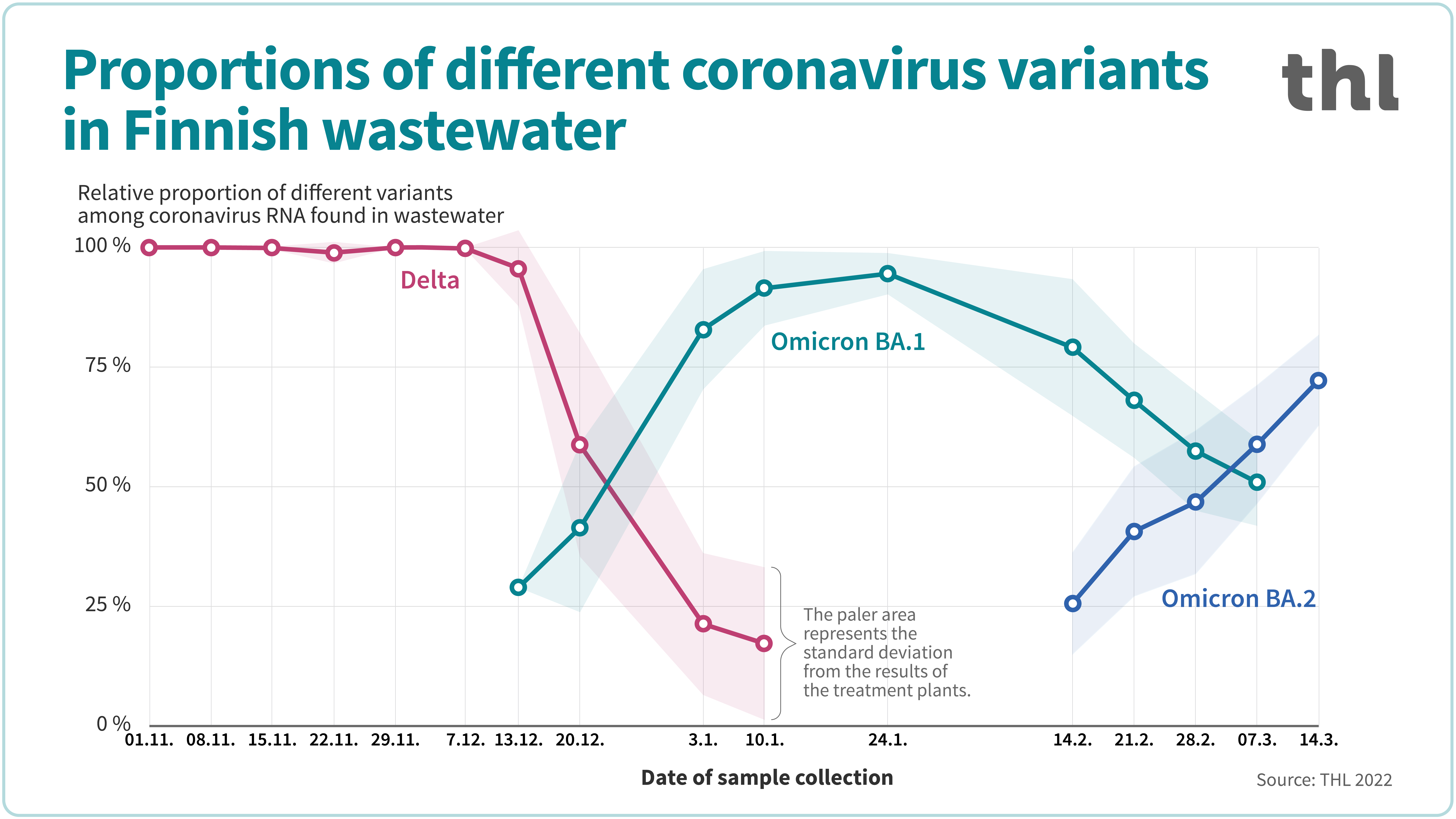Omicron BA.2 is now the most common coronavirus variant found in Finnish wastewater
The Omicron sub-variant BA.2 is the most common coronavirus variant found in Finnish wastewater, according to results obtained by the Finnish Institute for Health and Welfare (THL). By sequencing samples collected in THL wastewater monitoring, it is possible to measure the incidence of different coronavirus variants from the coronavirus RNA in the wastewater.
According to the monitoring data, the Delta variant was the most common in Finland until mid-December 2021. At the beginning of January 2022, the Omicron sub-variant BA.1 was found to have become more common in wastewater than the Delta variant. By mid-March, the most common was Omicron sub-variant BA.2.
The identification of coronavirus variants in wastewater is possible through the use of advanced sequencing techniques, even though the viral RNA is diluted in wastewater and may be damaged by environmental factors. THL began developing a method for identifying coronavirus variants from wastewater samples at the end of last year. The methodology has been developed to identify also the Omicron sub-variants BA.1 and BA.2 and to determine the proportions of the different variants.

Proportions of different SARS-CoV-2 virus variants in Finnish wastewater as found in the sequenced wastewater samples from monitored wastewater treatment plants between 1 November 2021 and 13 March 2022.
The first appearance of the Omicron BA.1 sub-variant in Finnish wastewater was obtained from a sample of Espoo’s untreated wastewater collected from 6 to 7 December 2021. In the preceding weeks and in other monitoring localities, this sub-variant had not yet been observed, although indications of the presence of the Omicron variant were also received from Viikinmäki, Helsinki, in the same week. In this respect, the results have become more precise than the previous preliminary results.
According to the successfully sequenced samples so far, the first appearance of the Omicron BA.2 variant was seen in a sample collected from the Tampere wastewater treatment plant from 2 to 3 January 2022.
In January–February 2022, the incidence of the Omicron sub-variants BA.1 and BA.2 increased throughout Finland, and between 20 and 21 February 2022, both variants were detected simultaneously in wastewater samples from as many as thirteen different locations.
According to the sequencing results completed so far, the last indications of the Delta variant in Finnish wastewater were observed in samples collected from 16 to 17 January 2022.
Not all collected wastewater samples have yet been analysed for coronavirus variants. Currently, the variant identification method only produces preliminary results from wastewater, and a sequencing delay of up to one month slows down the completion of results.
Further reading: Coronavirus variants in wastewater
Virus variants are also monitored from a sub-sample of nationwide, laboratory-confirmed COVID-19 positive individual test samples across the country by sequencing. Correspondingly with the wastewater results, the nationwide patient sample monitoring also found that BA.1 replaced the Delta variant in late December (week 51) and BA.2 rose to replace BA.1 as the main virus variant in early March (week 10). In the Helsinki and Uusimaa Hospital District (HUS), BA.2 has been a main virus variant since the beginning of the year.
Wastewater monitoring continues weekly
For coronavirus wastewater monitoring, the collection of samples will continue on a weekly basis. Based on the latest wastewater samples, collected between 3 and 4 April 2022, the total amount of coronavirus RNA in wastewater continues to increase.
Last week (3–4 April 2022), the largest ever RNA counts per 1000 people per day were measured in Jyväskylä, Kuopio, Tampere and Vaasa. In Rovaniemi, the upward trend of the last five RNA measurements has continued. In Joensuu, the upward trend of the last five measurements has now reversed. In other monitoring locations, RNA levels are high but have remained steady over the past two weeks.
The situational picture of the numbers of coronavirus observed by wastewater monitoring is independent of test activity, and it supports other epidemic indicators.
The coronavirus RNA levels are examined weekly from the wastewater samples of 13 localities. The samples are collected from the treatment plants in Espoo, Helsinki, Hämeenlinna, Joensuu, Jyväskylä, Kouvola, Kuopio, Lappeenranta, Oulu, Pori, Tampere, Turku and Vaasa. In addition, a sample is collected every two weeks from Rovaniemi and once a month from Pietarsaari and Seinäjoki.
The coronavirus RNA numbers detected in the samples are updated to the weekly report on wastewater monitoring on THL’s website once a week on Fridays at 12:00. As an exception, the results of the samples collected during Easter week (10–14 April 2022) will be updated on the website already on Thursday 14 April. Wastewater samples in which coronavirus RNA is detected are sent for sequencing in order to identify the coronavirus variants.
Further information
- Further information on coronavirus variants in wastewater
- Coronavirus variants can now also be identified in wastewater – first Omicron detections in the December samples, THL 21 January 2022
- Coronavirus infection caused by the Omicron variant has been detected in Finland, THL 2 December 2021
- Weekly report on wastewater monitoring for coronavirus (in Finnish)Link to an external websiteOpens in a new tab
- Coronavirus variants
Tarja Pitkänen
Chief Specialist
THL
tel. +358 29 524 6315
firstname.lastname@thl.fi
Anssi Lipponen
Senior Researcher
THL
tel. +358 29 524 7962
firstname.lastname@thl.fi



